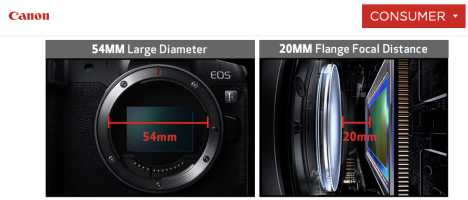And gosh, as **I** already told you, Nikon paid a huge price for that as their autofocus sucked for a decade or two and their lenses had to be designed around the small aperture.
Did they, though? Both Canon and Nikon introduced autofocus lenses in the late 1980s, and Canon became the ILC market leader in 2004. So, who led the market in the 'decade or two' after the introduction of Nikon's sucky autofocus? Gosh, it was Nikon. #factsbeatopinions
In contrast, no-one's illustrated some huge price that Canon would have had to pay by making the EF-M mount simply the RF mount albeit perhaps with the EF-M film-to-flange distance. Sure its a few mm bigger, but I don't think big enough that the cameras or lenses would be notably bigger or bulkier or more expensive or heavier. If I'm wrong about that, please tell me which M model or EF-M glass would no longer sell if it had an RF mount.
"The camera's
size, image quality, advanced video capabilities and the versatility of Canon's full lineup of lenses make the EOS M another great option to help our customers record and capture their creative vision," said Yuichi Ishizuka, executive vice president and general manager, Imaging Technologies & Communications Group, Canon U.S.A. Canon lists size first. As for noticeably bigger or bulkier, we'll get to that below.
Please tell me which APS-C cameras or EF-S lens would sell better if Canon had made EF-S lenses compatible with FF cameras? You can't, nor can I tell you which cameras or lenses would have sold less well if they were a bit (or more than a bit) bigger. But the whole woulda-shoulda-coulda speculation is irrelevant. Canon designed the M mount the way they did, and the M line became a global sales leader.
You got me. The M2 would be 4mm taller, less than 2/10" in America-speak. That would of course let you cram just that much more hardware inside vertically, making the camera a bit narrower and/or shallower, no?
...and if some M models need to be a couple mm taller, they can then be a couple mm narrower or shallower. You seem to be thinking I'm demanding more volume inside the camera. Not at all.
Gosh, your math is sure selective! Your ability to ignore established facts and your own previous statements is really quite impressive.
You're suggesting that a 7mm greater throat diameter can be accommodated by a 4mm increase in height. How would that work? By eliminating the already minimal space above/below the mount so the mount goes right to the edge of the camera? Maybe possible, but unlikely. And the greater vertical height would enable them to make the camera shallower? Golly gee, you seem to have forgotten that you also wanted the 20mm RF flange focal distance instead 18mm of the EF-M...so it wouldn't be shallower (unless you conveniently ignore your prior statements).
Likewise you say the RF mount is 54mm and EF-M lenses typically 60mm in diameter? In other words the lenses wouldn't be any bigger at all, would they?
Evidently you don't understand what throat diameter means. Let's try an anatomical analogy – if your throat was the same diameter as your neck, you could spew a lot more BS from your head.
The throat is the inner diameter of the lens mount, not the diameter of the full mount.

The outer diameter of the EF-M mount is...60.7mm, essentially diameter of all the EF-M lenses (they are all flush with the edge of the thin black ring around the silver mounting surface, which is the place the rubber ring on weather-sealed lenses actually seals on FF cameras). The outer diameter of the RF mount is 69mm, meaning had Canon used the RF mount for M cameras, all the lenses would be 13% larger in diameter, meaning a 28% larger volume assuming the lenses stayed the same length. That's a far cry from 'wouldn't be any bigger at all', isn't it? #factsbeatopinions
- Thanks, finally some numbers to work with.
If only you knew how to work with them properly, but evidently you don't. Sad.
YES BUT ONLY BECAUSE THE M LINE WASN'T THE R LINE. You're presenting the fact that Canon did the very thing, the stupid thing, I'm arguing against, as an argument that they had to make that decision.
In the EF world we had one system from pros to neophyte weekenders. People are arguing here that somehow Canon is clearly thought this all through and for THIS era, with LOWER sales, is magically maximizing profits with TWO SEPARATE SYSTEMS, and yet the same camera company with, you'd think, the same brainpower, thought in the PREVIOUS era, when sales were much HIGHER, that ONE system would serve everyone.
Did you forget that EF-S lenses don't mount on FF DSLRs? They had two systems of lenses, and the
EF-S lens list comprises a full system of ultrawide to telephoto zooms with a couple of primes and a macro lens. Oh my goodness, that list sounds a whole lot like the
EF-M lens list, doesn't it? But sure, Canon didn't think about that at all, either, right?

Because if they had, you might be tempted to believe that that Canon's data suggest APS-C users mostly stay APS-C users, and those relative few who upgrade to FF end up changing out most or all of their lenses, meaning mount compatibility is not very important.
Just to be clear what I'm saying would have been smart:
- When introducing the M system, give it the dream FF mirrorless mount. Basically the RF's diameter and system bus. Flange distance could be the EF-M's 16mm (18mm??) or the RF's 20mm, I don't think it matters too much. As you say, some M bodies might have been 4mm taller and correspondingly narrower or shallower. I can't imagine that would have torpedoed sales.
- In addition to lenses with a small image circle, make a few more lenses like 24/2.8, 28/2.8, 35/2, 50/1.8, with full image circles. "Don't bother telling anyone" as it doesn't start to matter until the R body comes out.
- R comes out, with its initial 3-4 lenses... but it turns out, hey presto, another 4 lenses long used by M shooters work full-image on the R! And all the small-sensor ones do too! And if you choose to use those with the small image circle, then you can shoot now and tweak framing later. Take any shot and make it a vertical shot. Or make it square or 2:3 or 9:16 or 4:3 without wasting pixels. Or rotate it a few degrees to straighten up the angles without having to throw away pixels. The result is that an 18-55 zoom on the M works on the R and gives you the same MP as the typical M body and same "reach", when that's convenient for you. And when not, then use big-boy full-frame lenses.
- Meanwhile put any of your big-boy full-frame lenses on your M body. Maybe you're backpacking but want that pro-quality macro, or what have you.
Just to be clear, you're saying:
- Bigger bodies, and >25% bigger lenses, would have been a good idea for the EOS M line.
- Making lots of prime lenses with big image circles, meaning not just 25% larger but substantially heavier, and aimed at a target market that has a strong preference for zooms over primes, would have been a good idea for the EOS M line.
- When the R came out, a major target market was current owners of EOS M cameras, as opposed to current DSLR owners. (Would love to see you data to support that claim, although we both know you don't have it, but as I keep saying, Canon does.)
- Using RF lenses on an APS-C camera is a major advantage, even though cropping negates much of the optical advantages those lenses provide, or what have you.
Quite frankly, none of that even remotely sounds smart.




